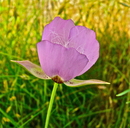Taxon Report
Calochortus longebarbatus Wats. var. longebarbatuslong-haired star-tulip |
 ©2020 John Doyen |
Taxon Summary
Calochortus longebarbatus var. longebarbatus, commonly known as long-haired star-tulip, is a perennial bulbiferous herb in the Liliaceae that is found in California and elsewhere. It occurs within Great Basin scrub, Lower montane coniferous forest (openings, drainages), Meadows and seeps, and Vernal pools, growing at elevations from 1005 to 1900 meters. Calochortus longebarbatus var. longebarbatus is ranked 1B.2, Plants Rare, Threatened or Endangered in California and Elsewhere; Moderately threatened in California.Classification
|
Scientific Name: |
Calochortus longebarbatus Wats. var. longebarbatus |
|
Common Name: |
long-haired star-tulip |
| Family: | Liliaceae |
| Element Code: | PMLIL0D0R1 |
| USDA Plants Symbol: | CALOL |
|
Synonyms/Other Names: |
|
Ecology and Life History
| Lifeform: | perennial bulbiferous herb |
| Blooming Period: Jun-Aug(Sep) | Jun-Aug(Sep) |
| Elevation: | 1005-1900 (3295-6235) |
| General Habitats: | Great Basin scrub, Lower montane coniferous forest, Meadows and seeps, Vernal pools |
| Microhabitat: | Clay, Mesic |
| Microhabitat Details: |
Conservation Status
| CA Rare Plant Rank: | 1B.2 |
| Global Rank: | G4T3 |
|
State Rank: |
S3 |
| State List: | None |
| Fed List: | None |
| Other Status: | BLM_S; SB_BerrySB; USFS_S |
|
CRPR Changes: |
|
Occurrence Data from the CNDDB
| Total Occurrences: | 150 |
| Element Occurrence Ranks: | |
| Excellent (A) | 21 |
| Good (B) | 56 |
| Fair (C) | 30 |
| Poor (D) | 8 |
| None (X) | 2 |
| Unknown (U) | 33 |
| California Endemic: False | |
| California Counties and Islands: Name (Code) | |
| Lassen (LAS), Modoc (MOD), Shasta (SHA), Siskiyou (SIS) | |
| Quads: Name (Quad Code) | |
| Adin Pass (4112038), Ambrose (4112058), Bartle (4112137), Burney (4012186), Burney Mtn. West (4012176), Crank Mountain (4112142), Day (4112123), Dead Horse Summit (4112127), Donica Mtn. (4112132), East of Pondosa (4112125), Egg Lake (4112133), Halls Canyon (4112131), Hambone (4112136), Happy Camp Mtn. (4112141), Hollenbeck (4112143), Indian Spring Mtn. (4112135), Jacks Backbone (4012166), Knobcone Butte (4112151), Lookout (4112122), Pittville (4112113), Pondosa (4112126), Spaulding Butte (4112152), Washington Mtn. (4112048), Whitehorse (4112134) | |
Threat List Data from the CNDDB
| Threat List Total: | 10 | |
| EOs with Threat Listed: | Total EOs | % of EOs |
| 111 | 74 % | |
| Grazing | 80 | 53% |
| Logging | 58 | 38% |
| Road/trail construction/maint. | 16 | 10% |
| Foot traffic/trampling | 14 | 9% |
| Other | 11 | 7% |
| ORV activity | 5 | 3% |
| Non-native plant impacts | 2 | 1% |
| Erosion/runoff | 1 | 0% |
| Recreational use (non-ORV) | 1 | 0% |
| Surface water diversion | 1 | 0% |
Selected References
| Proceedings of the American Academy of Arts and Sciences 17:381 (1882) |
| Proceedings of the California Academy of Sciences III 2:130 (1901) |
| Calochortus longebarbatus var. longebarbatus profile for potential Species of Conservation Concern evaluation (2021) |
Citation
California Native Plant Society, Rare Plant Program. 2025. Rare Plant Inventory (online edition, v9.5.1). Website https://www.rareplants.cnps.org [accessed 28 December 2025].